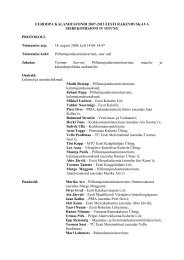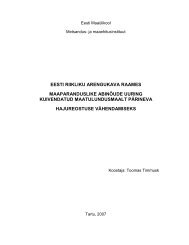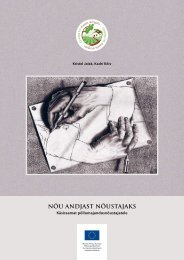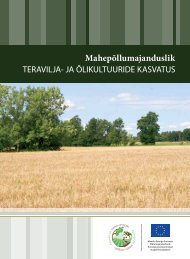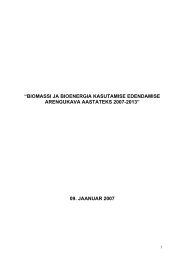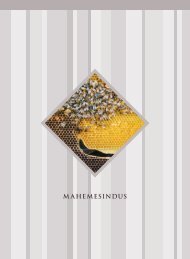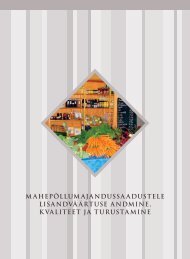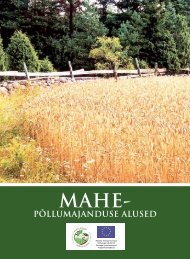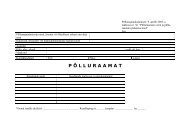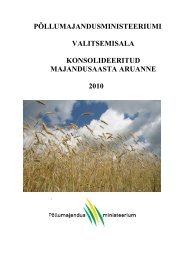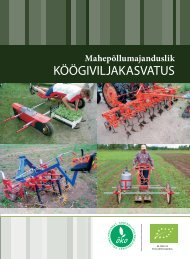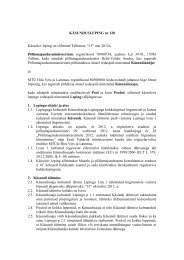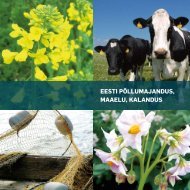estonian agriculture, rural economy and food industry
estonian agriculture, rural economy and food industry
estonian agriculture, rural economy and food industry
Create successful ePaper yourself
Turn your PDF publications into a flip-book with our unique Google optimized e-Paper software.
11.<br />
tion areas. The areas belonging to the network need<br />
not always establish a strict conservation regime or<br />
ban all human activities. In each area of Natura<br />
2000, the habitat types <strong>and</strong> habitats of species are<br />
protected for which the area has been designated.<br />
The Natura 2000 network includes nature conservation<br />
areas <strong>and</strong> bird sanctuaries. But conservation<br />
of the areas alone is not enough. Valuable agricultural<br />
l<strong>and</strong>scapes <strong>and</strong> the habitats of birds <strong>and</strong> animals<br />
are preserved when economic activities use<br />
natural resources in a sustainable manner.<br />
Support is available for l<strong>and</strong><br />
maintenance<br />
Since 1996 the farmers of Matsalu nature conservation<br />
area are paid for producing hay for grazing<br />
animals on the coastal <strong>and</strong> bottom-l<strong>and</strong> meadows.<br />
This way, the diversity of nature is preserved <strong>and</strong><br />
the <strong>rural</strong> development of the area is also supported.<br />
Another method of paying subsidies is the <strong>agriculture</strong><br />
environmental programme, which is aimed<br />
at preserving the l<strong>and</strong>scape <strong>and</strong> biological diversity<br />
of agricultural l<strong>and</strong>. Environmental subsidies are<br />
paid on the principle that an agricultural producer<br />
assumes a long-term (at least five year) obligation<br />
to shift to environmentally-friendly production.<br />
The producers are compensated for income foregone<br />
<strong>and</strong> for the additional expenses incurred due<br />
to such activities. The <strong>agriculture</strong> environmental<br />
programme has been in preparation since 1997.<br />
The programme was launched in part in 2000<br />
(including in respect of organic farming).<br />
The <strong>agriculture</strong> environmental programme<br />
consists of four action plans:<br />
environment-friendly <strong>economy</strong>;<br />
additional measures (organic farming, local<br />
endangered breeds <strong>and</strong> varieties, natural diversity,<br />
establishment of ponds <strong>and</strong> wetl<strong>and</strong>s);<br />
maintenance of discarded, overgrown agricultural<br />
l<strong>and</strong>;<br />
training <strong>and</strong> sample projects.<br />
The objectives of an environmentally-friendly<br />
<strong>economy</strong>, which is the first priority of the action<br />
plan, are:<br />
preservation of natural <strong>and</strong> semi-natural<br />
communities <strong>and</strong> valuable l<strong>and</strong>scape elements, protection<br />
of objects of historical <strong>and</strong> archaeological<br />
interest, <strong>and</strong> improvement of the visual appearance<br />
of l<strong>and</strong>scapes (articulation of fields larger than<br />
20 ha by strips of perennial plants);<br />
establishment or preservation of strips of perennial<br />
plants on the edges of fields adjacent to<br />
non-arable l<strong>and</strong>;<br />
conservation <strong>and</strong> restraint from damaging<br />
natural <strong>and</strong> semi-natural communities <strong>and</strong> valuable<br />
l<strong>and</strong>scape elements <strong>and</strong> objects of historical <strong>and</strong><br />
archaeological value;<br />
cutting grass on clear l<strong>and</strong> not in agricultural<br />
39



